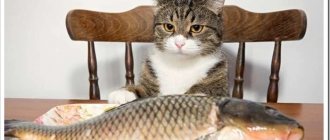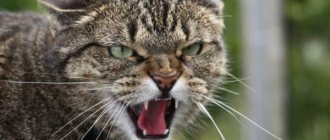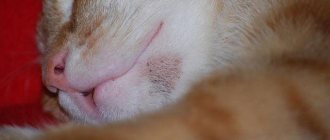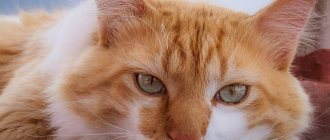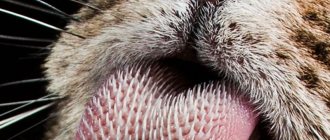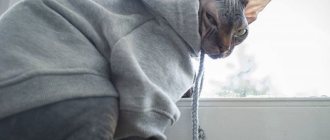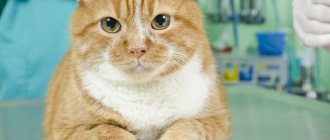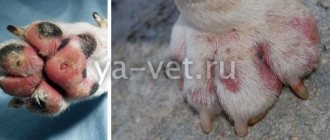Possible consequences
For domestic cats, thread often becomes a subject of play and the pet can swallow it along with the needle, which is very dangerous for your pet’s health. A cat's tongue is designed in such a way that the animal cannot independently remove debris from it. Accordingly, the pet will be forced to swallow the thread and needle. Only in 7% out of 100 does it happen that the needle passes through the esophagus and leaves the body naturally. However, you should not rely on luck in such situations and it is better to immediately provide help to your pet as soon as you notice that the cat has eaten a needle.
Once in the body, the needle can damage internal organs and this can happen at any time, even a few days after ingestion. Initially, the cat may not react in any way to what happened and will continue to lead normal life activities. If the needle damages the esophageal mucosa, the following symptoms may occur :
- Refusal to eat;
- Fever;
- Lethargy;
- Urge to vomit.
Can a person accidentally swallow a needle?
No matter how funny and ridiculous it may sound, there are many sudden cases in which you can swallow a needle:
- A sane, normal person will not just swallow a needle. But imagine a situation where you need to sew something up, and in order to straighten the fabric or see how the seam turns out, you put the needle in your mouth and suddenly sneezed, yawned, or hiccupped. In half of these moments, the needle, under the influence of air, instantly gets into the throat. A large percentage of cases of needles entering the body are among fashion designers and seamstresses.
- Very often small children swallow needles. Studying the world around them, the little ones try everything to their teeth. Crawling and playing on the floor, it is not difficult for them to find a needle that their mother accidentally dropped earlier.
- There is an ancient tradition of fortune telling using cookies, which determine a person’s fate. Small notes with wishes, buttons, decorations and even needles and pins are baked inside them. From hour to hour there are cases when during this fortune-telling people accidentally swallow a needle.
- In ancient times, a ritual of “devotion” was performed, during which a person swallowed a needle to prove his submission, fidelity, innocence and purity. The survivor after swallowing the needle was considered a righteous person, and the deceased was considered a liar.
- Prison inmates often use a needle to try to get into the infirmary. Others put needles in the food of their fellow inmates to take revenge for insults.
- In some cases, people quite deliberately swallow needles and make money from it. For example, when performing tricks, circus performances.
What to do
From the fuss of action and the desire to provide help on your own, your cat may suffer first of all. Swallowing a needle and thread is a big threat to your pet’s health, so you need to be careful. Your first action in such a situation should be to call the veterinary clinic. Try to always have such numbers in your phone book so as not to waste time.
You can transport your cat to the hospital yourself in a special bag, but it is worth considering that sharply grabbing and unnerving your pet is strictly prohibited. It is better to call a veterinarian at home to accompany you to the clinic.
At home, it is impossible to solve the problem of swallowing a needle, since an x-ray is needed to detect the location of a foreign body in the body. Remember, if your cat or dog swallows a needle, it is strictly prohibited :
- Try to pull the needle yourself by the end of the thread, as this can significantly worsen the situation;
- Postpone a visit to the veterinarian until the last minute;
- Feel the pet.
After admission to the veterinary clinic, the animal is prescribed an X-ray examination and, at the discretion of the doctor, a number of tests. The veterinarian then determines how the foreign object will be removed. Surgery or endoscopic removal is possible. When a cat swallows a thread and a needle, serious intervention is required, followed by a rehabilitation period. The veterinarian will determine the period during which the pet will need to stay in the hospital after surgery for better recovery.
In most cases, if a cat that has swallowed a thread with a needle is not given timely help, it dies. You cannot say that the cat will cope with the problem on its own and hope that the needle will not catch the internal organs. Regardless of whether the stomach or other internal organs are damaged, the consequences can be extremely dire. Take care of your pets and do not leave such dangerous objects as thread and needle unattended. If you suspect that your cat has swallowed a foreign object, it is better to consult a doctor immediately so as not to regret wasting your time.
Source
The cat swallowed a needle or foreign bodies in the gastrointestinal tract of cats
If you have a cat in your house, you will have to maintain order. A cat may eat foreign objects for various reasons.
Firstly - games. Cats just have fun playing with threads, rubber bands, small toys that you dropped in a hurry, or children scattered on the floor, on the sofa, etc. New Year's "rains" are often eaten. The toys themselves, intended for cats, should be assessed by you from the point of view of safety and, so to speak, eatability. Perhaps a new toy will seem harmless to you, keep in mind that when it gets old and worn out, the toy can begin to fall apart, lose parts, and must be replaced in time with a stronger one. Bags and paper also occupy a high position in terms of being eaten by representatives of the cat tribe.
Secondly, a cat is a predator and, having caught an impromptu mouse, may well “get into character” and try to eat it, the so-called “hunter-prey” syndrome.
Thirdly, on the street, a cat can eat grass, followed by vomiting, to cleanse the stomach of woolen bezoars. Bezoars are hairballs that form when an animal grooms its coat. If the owners do not periodically supply the cat with grass (clean, sprouted at home, especially for these purposes), it may try to use threads, etc., for this purpose. But threads, elastic bands and “rains” inside a cat behave completely differently than grass. The intestines can literally be strung on a thread, assembled into an accordion, causing inflammation, torsion, intussusception, necrosis, perforation, etc.
In addition, there is such a thing as “perverted appetite.” The desire to eat non-edible objects may arise, for example, with pancreatitis - inflammation of the pancreas, vitamin deficiencies, problems with the thyroid gland, if feline viral leukemia is suspected, etc.
That is, it is important to recognize in time whether it is necessary to consult a veterinarian, even before signs of intestinal obstruction or symptoms of a foreign body in the mouth appear.
Another reason could be poor nutrition or poor quality food. Dangerous are chicken and fish bones, joints and fragments of other bones... Some foreign authors identify a genetic factor. A predilection for chewing, sucking and licking cotton, wool, synthetic and other things can often manifest itself in Siamese cats.
The next reason is stress and lack of attention, and similar symptoms can occur if the kitten is taken away from its mother too early or as a violation of the sucking reflex. That is, psychological problems.
In the photo there are x-rays of a cat who did not intend to swallow the needle; she, like most people, ate the thread, and the sewing needle was a bonus. It could have cost her her life. Fortunately, the owners realized what had happened in time, took the poor thing to the veterinary clinic, and the problem was successfully resolved. In this case, the needle did not reach the stomach or intestines, however, not everyone is so lucky. Be careful, consult a veterinarian in a timely manner if you notice only signs of a perverted appetite in the animal.
If there is a foreign body in the mouth, the cat shows signs of pain, cannot eat, perhaps rubs its face with its paw or rubs against various objects, trying to remove the foreign object, and profuse salivation may appear. If the problem is located in the esophagus, the cat may choke (a foreign body may block the larynx or pinch the trachea). If there are problems in the esophagus, stomach, or intestines, vomiting, constipation, acute abdomen, etc. occur.
Without delay, show the animal to the veterinarian as soon as possible. Sometimes the problem is obvious. But more often, the cat may need a thorough examination, possibly under general anesthesia, an X-ray examination, possibly also a contrast one, ultrasound, blood tests and other studies to confirm the diagnosis.
Chief physician of the veterinary clinic "UMKA" Yana Aleksandrovna Latsapneva
What is the danger
Seeing the thread, the cat immediately remembers his childhood, the piece of paper on the thread and the fun of fussing with it. Therefore, not a single cat will pass by such an interesting item. At risk are young animals, kittens and pets left to their own devices for a long time. Young animals, due to lack of experience or for fun, can swallow a needle, thread, buttons, snaps and other small objects.
The structure of a cat's tongue. Furry pets, unfortunately, very often swallow sharp objects and, as a rule, this leads to their death. The problem is not that the cat is stupid and cannot “spit out” an inedible, dangerous object. The structure of a cat's tongue is such that a thread that gets into the mouth can only be swallowed.
The tongue has hard tubercles directed towards the esophagus. As it turned out, the tips of the tubercles have a U-shaped structure. With this “fork” the animal rips meat off the bones of its prey and takes care of its coat. A pet can only swallow a thread caught in these “flyers”, otherwise it is impossible to get rid of it. And along with the thread, the needle is sent into the esophagus.
Consequences and risks
The needle can pierce the stomach, intestines and damage other organs adjacent to them, or penetrate muscle tissue. Various options for passing a sharp object are fraught with:
- perforation of the digestive tract;
- development of erosion, ulcers, neoplasms;
- tissue necrosis;
- internal bleeding;
- peritonitis;
- mucosal injury followed by inflammation;
- dehydration as a result of vomiting and diarrhea;
- exhaustion due to refusal of food, intestinal obstruction;
- damage to internal organs.
Even if the needle is very “successfully” located in the body and does not cause any disturbance to the animal, after a while it will begin to oxidize under the influence of biological fluids and digestive juices.
Metal oxides can cause purulent melting of tissues and blood poisoning.
Signs of internal damage
If a cat swallows a sewing needle, it may exhibit symptoms characteristic of gastrointestinal injuries:
- loud meowing and rubbing of the face;
- apathy, lying motionless in one place;
- refusal of food and water;
- profuse drooling;
- nausea and vomiting, possibly with traces of blood;
- hiccups or belching;
- bloody streaks in the stool;
- constipation, flatulence, bloating.
If the needle is stuck in the throat, palate or esophagus, the cat strains its neck, often swallows, coughs, and wheezes. Don't worry if your cat behaves normally, doesn't show anxiety, and there are no signs of damage.
Symptoms of chronic sinusitis
- the course of the disease is paroxysmal: remissions are replaced by exacerbations of the disease;
- during exacerbations, symptoms of acute frontal sinusitis appear; during remission, pressure and heaviness in the frontal part of the head remain, which increases with bending and loads;
- throbbing pain appears in the temples; bothered by a constant aching headache;
- there is nasal discharge, often mixed with pus and blood; but there is no feeling of complete congestion;
- swelling and pressure in the eyes persist;
- in the morning, due to the drainage of purulent mucus along the back wall of the throat, expectoration of sputum and nausea may occur;
- fatigue is increased.
One of the main indicators of the development of the pathological process during frontal sinusitis is temperature. In the acute form, which lasts 3 weeks with proper treatment, hyperthermia can reach 38°C - 40°C. In the chronic form, the temperature may be slight or absent altogether. But the absence of temperature with frontal sinusitis does not indicate recovery, because the characteristic pain remains.
The main signs of frontal sinusitis are constant aching headaches. They are in the nature of expansion, compression, pulsation, intensifying when the head is tilted forward or when performing physical activity. Pain may occur due to vibration when traveling in transport.
With hypothermia or the consequences of acute respiratory viral infection, the pressure in the frontal sinuses increases and the pain increases. Insomnia and mental stress, overwork and drinking coffee or alcohol can increase headaches even without exacerbation of the disease. The pain becomes unbearable, neurological.
The most intense point of pain in the forehead is noted above the bridge of the nose (2 cm higher). If one of the sinuses is inflamed, the pain is more localized on one side. When you tap on the forehead, aching pain appears. If there is inflammation when pressing on the superciliary tissue, the pain will last a long time.
Helping an injured pet
If such a dangerous “trouble” does happen to a mustachioed tabby, then the owner should not waste time in the hope that everything will work out and the needle will leave the body with the feces. The fact is that food that enters the animal’s gastrointestinal tract passes through the tract in 12-24 hours. And the intestines are “folded” into loops, and sooner or later the needle will get stuck somewhere.
According to statistics, only in 2% of cases an object is independently “evacuated” from the body without serious injury or damage.
Therefore, the owner will have to take a number of urgent measures.
What to do to save your pet
As soon as the owner discovers that sewing supplies are missing or suspects that the cat has swallowed threads or needles, it is necessary:
- contact a veterinarian and call him to your home;
- help organize transportation of the pet to the veterinary clinic.
Causes of gastric obstruction in cats
Why do domestic cats swallow inedible objects? Polyphagia - a perversion of appetite that manifests itself in some pathologies, when animals purposefully eat everything - is quite rare. The reasons for swallowing various things are in most cases quite banal, and gastric obstruction in a cat is most often a consequence of:
- a game in which the cat accidentally swallows an object;
- eating inedible things that have a pleasant smell, for example, a bag containing meat or sausage packaging;
- chewing rustling objects (cats like to chew cellophane, tinsel, etc.);
- feeding bones, especially those that have undergone heat treatment;
- accumulations of wool in the stomach.
Small objects can remain in the lumen of the stomach, completely blocking its work, or pass into the intestines, causing obstruction in the lower gastrointestinal tract.
Swallowed threads, ribbons, rain from the Christmas tree - what surgeons call linear bodies, are capable of stretching along a significant portion of the gastrointestinal tract, collecting intestinal loops, injuring the walls of organs, causing perforation and necrosis.
If part of a swallowed linear body is visible from the cat's anus, under no circumstances should you pull it out! Such objects very rarely leave the body on their own; if pulled, they can simply cut the intestines.
Some small objects can gradually accumulate in the stomach if their size does not allow them to pass further into the duodenum, causing a gradual increase in symptoms and deterioration in the cat's well-being.
Sharp objects such as needles and bones in a cat's stomach can injure the stomach wall, causing cuts and punctures, affecting nearby organs and migrating into the abdominal cavity.
Diagnosis and treatment
At the veterinary clinic, the doctor will prescribe and conduct an instrumental examination, including:
- X-ray – the image will immediately show how and where the needle is located. To identify the thread, an X-ray examination with a contrast agent is performed.
- Ultrasound - an ultrasound examination will allow a specialist to assess the condition of organs adjacent to the gastrointestinal tract that could be injured by a needle.
- Gastroscopy – using a gastroscope, the doctor will examine the digestive system and assess the damage caused by the needle as it passes.
Blood and urine tests are prescribed less frequently - if abdominal surgery is necessary and after removal of a sharp object.
Surgical treatment
In order to remove the needle, the following is prescribed:
- abdominal surgery, when the animal is opened and, after removal, sutured;
- endoscopic intervention - the operation is performed laparoscopically - through small punctures that do not require sutures and long-term rehabilitation.
Surgical techniques. Depending on the location of the needle, different surgical techniques are used, namely:
- enterotomy – from the intestines;
- gastrotomy - from the stomach;
- esophagotomy - from the esophagus.
After the operation, the animal remains in the clinic for some time under the supervision of a doctor.
Recovery period
If the cat is weakened and has lost a lot of blood and fluid, then she is prescribed maintenance therapy:
- infusions of nutrient solutions, vitamins;
- infusion of blood substitutes, saline.
To avoid secondary infection and postoperative complications, antibiotic therapy is prescribed. The cat is on a starvation diet for 24 hours. Then they begin to give him liquid food in small portions.
To avoid worries and eliminate serious consequences for the health of the pet and the psyche of the owner, you need to avoid throwing sewing supplies and other small items in the access area of the furry mischief-maker.
Source
Common pathologies
Cows often suffer from pathologies of the digestive system. They pose a serious danger to the life of the ruminant animal. Common digestive problems in cows:
- bloating;
- stop;
- blockage;
- injury.
Bloating
Tympany or bloating is a very dangerous condition that occurs due to a sudden change in the cow’s diet, the animal consuming large quantities of food that promotes increased gas formation. Tympany may occur due to a blockage in the esophagus. Symptoms:
Tympany
- Refusal to eat.
- Enlarged abdomen.
- No chewing gum.
- Anxiety.
- In severe cases - shortness of breath, pallor of the mucous membranes.
Methods to help with bloating include:
- Removal of a foreign body from the esophagus using a flexible probe.
- Stimulation of the stomach to start it.
- The use of medications that prevent gas formation and fermentation - Timpanol, burnt magnesia, activated carbon, ichthyol.
- In emergency cases, they resort to perforation of the scar with a trocar.
You can open up your stomach with a massage. It is performed on the left side of the abdominal cavity, in the area of the hungry fossa, with a fist. Pouring the area with cold water often helps. A cow needs to run to get her stomach working.
Stop
The digestion process often stops in cows due to improper feeding, for example, if concentrates predominate in the diet or the animal has eaten rotten hay. Also, gastric arrest occurs when the esophagus is blocked. Symptoms of the pathology: loss of chewing gum and appetite, general depression. If the cow's stomach has stopped, this can be checked. You need to lean your fist into the area of the hungry pit and listen to whether contractions occur.
Treatment of this pathology begins immediately. The first thing to do is to keep the animal on a starvation diet for 24 hours. In the future, digestible feed is gradually introduced - silage, a small amount of root vegetables, high-quality hay.
Silage
To start the stomach use:
- Hellebore tincture.
- Gastric lavage.
- You are given a saline solution, vodka or moonshine to drink inside (can be diluted with vegetable oil).
- Scar massage.
Zaval
Sometimes the stomach stops due to a blockage of the book. This happens when the animal’s diet is dominated by dry food, bran or grain waste. The cause of the pathology may be sand or dirt in the feed. The symptoms of a blocked book are similar to those observed when the stomach stops. It is quite difficult to identify the true reason for the cessation of digestion. For diagnosis, a puncture of the stomach with a needle is used. If it enters with difficulty, it means that we are talking about a blockage.
If the diagnosis is confirmed, it makes sense to rinse the stomach. To do this, use a solution of sodium sulfate or chloride at a concentration of 10%. The procedure will require about a liter of this solution. To start the digestion process, use the same means as discussed above - vegetable oil, hellebore tincture, vodka.
Injury
Since the cow swallows unprocessed food, dangerous objects - wire, nails, wood chips, sharp stones - often get inside along with the food. Such foreign bodies can cause serious injury to the animal - piercing the stomach or piercing its walls. Mesh injuries are often through, sharp objects can hit nearby organs - the heart, spleen, lung.
Symptoms of traumatic reticulitis:
- Anxiety, loss of appetite.
- Stretching the neck forward.
- The cow takes unnatural poses - hunches over.
- Sometimes the temperature rises by 0.5-1 degrees.
- The animal feels pain when pressing on the sternum area.
Treatment is aimed at removing the foreign object from the stomach. Metallic foreign bodies are removed with a magnetic probe. If it is not possible to remove the object, they resort to surgery or the animal is slaughtered.
All parts of the stomach of ruminants perform their functions. If at least one of them stops working, the entire digestive system suffers
It is important to diagnose the development of pathology in time and begin treatment
Gastronomic deviations
Cats of any age love to chew inedible objects. They bite houseplants, including cacti, and try tools and cutlery. There are several reasons for this interest:
“attractive” smell of objects;
In the latter case, the thread can serve as the engine of the toy. Seeing the owner darning a hole or scribbling, the pet may rush at a moving object. The metal has a specific smell; pins are additionally attracted by the “aroma” of the plastic heads. These are the ones your pet can chew on.
Foreign body symptoms
After ingestion, a foreign body may not manifest itself in any way: more often such objects pass through the digestive tract asymptomatically. Pathological manifestations develop when they get stuck.
Foreign body in the esophagus
If a foreign body becomes stuck, it usually occurs in the esophagus. In such cases, the person may feel like they are choking. The following symptoms may appear:
- difficulty swallowing;
- sensation of a foreign object in the throat or chest (if the object is blunt);
- pain in the throat or chest (if the object is sharp);
- retching, nausea;
- cough, noisy breathing;
- excess saliva;
- blood in saliva.
Foreign body in the stomach or intestines.
- pain and/or cramps in the abdomen;
- flatulence;
- bloating;
- loss of appetite,
- nausea, vomiting;
- fever;
- blood in feces;
- diarrhea or constipation.
Foreign body in the rectum
Sometimes a foreign body can travel almost the entire gastrointestinal tract, but become stuck in the rectum. In such cases, there may be acute pain during bowel movements, and blood may be found in the stool.
Taste preferences
Men may be upset, but in fact, the process of swallowing seminal fluid causes genuine pleasure in a small number of women. Basically it is the desire to please your partner. To prevent it from developing into a gag reflex, you should think about the taste of sperm. Frankly speaking, he is quite peculiar. It is easy to improve the aroma and taste of the liquid: shortly before the act, you need to eat pineapple, banana, strawberries and other aromatic fruits. A sweet diet the day before the planned pleasure will also improve the taste of the ejaculate. In this case, the question of the lady’s disgust will probably not arise, and the man will get what he wants.
Take care of your own body, and let intimate relationships bring you mutual pleasure.
Taste preferences
Men may be upset, but in fact, the process of swallowing seminal fluid causes genuine pleasure in a small number of women. Basically it is the desire to please your partner. To prevent it from developing into a gag reflex, you should think about the taste of sperm. Frankly speaking, he is quite peculiar. It is easy to improve the aroma and taste of the liquid: shortly before the act, you need to eat pineapple, banana, strawberries and other aromatic fruits. A sweet diet the day before the planned pleasure will also improve the taste of the ejaculate. In this case, the question of the lady’s disgust will probably not arise, and the man will get what he wants.
Take care of your own body, and let intimate relationships bring you mutual pleasure.
Before discussing anything, remember: if someone swallows a needle, go to the hospital immediately for an x-ray! And it doesn’t matter whether it’s a child, an adult or a pet. There is an opportunity - hurry to the doctor, do not leave it to chance, because the consequences of delay can be terrible
And only if doctors are out of your reach, and you will have to wait too long for help, should you consider some other options. What to do if you swallow a needle and the hospital is far away
In such a situation, it is necessary to reduce physical activity to a minimum so as not to provoke a fatal “injection”. Sudden movements and bending are also contraindicated. Ordinary emergency care, used when something unwanted enters the body, is not suitable in the case of a needle. This means that the victim: cannot be induced to vomit; Do not knock on the chest; and even more so, you should not press sharply on the stomach, in the hope that the needle will pop out on its own. In addition, if a child swallows a needle, there is no need to turn him over and shake him.
What can happen if you swallow a needle? It is impossible to predict the final outcome of needle swallowing with 100% certainty. But there are several scenarios according to which events usually develop. In the most dangerous case, a swallowed needle will enter the lung or heart and make a hole there, which without surgical intervention will lead to death.
Of course, death will not come instantly (although in some cases everything happens extremely quickly - within a few hours), but the inflammation provoked by the needle will ultimately lead to either the loss of part of the lung (with a delayed operation) or death (if without doctors). The location of the needle inside the body is detected using x-rays. And if the lung or heart is damaged, then immediate surgical intervention is needed. If the needle reaches the stomach, then the probability of a successful natural outcome (literally) is 80%. That is, the needle will most likely come out in the feces. True, the remaining 20% are forced in most cases to undergo surgery to remove excess metal from the body. How to remove a swallowed needle from the body - a folk method
So, the recipe is close to the one that was used in ancient times: take 1-2 grams of cotton wool, soak it in petroleum jelly (not petroleum jelly!) and swallow, after a while eat a plate or two of oatmeal or semolina. If there is no petroleum jelly, then it is better to exclude cotton wool from the “treatment” altogether - the enveloping effect of the porridge should be enough. If the course of the “disease” is favorable, the needle comes out within 2 hours to 3 days. Therefore, either try to get to the doctor during this time, or be patient.
What to do if a dog or cat swallows a needle Pets require the same things as people. That is, you need a veterinarian and an x-ray, and then either an operation or enveloping porridge and Vaseline oil. You should not give a laxative, as its action can cause damage to the gastrointestinal tract. By the way, if it seems to you that a cat or dog has swallowed a needle, this does not mean that it is so. Often the needle gets stuck in the roof of the mouth or throat. True, this does not affect the assistance scheme in any way. Now you know what happens if you swallow a needle. Try to do everything right.
For reference: children swallow needles 3-4 times more often than adults, and in animals such a nuisance is almost the norm.
Every person remembers how, as a child, his parents frightened him with the story that if you swallow a needle, it will travel through the veins to the heart, causing death. But is this really true? What actually happens if you swallow a needle, what determines the degree of danger? Let's figure out how dangerous this incident is for the life of the human body and what to do to avoid fatal consequences.
